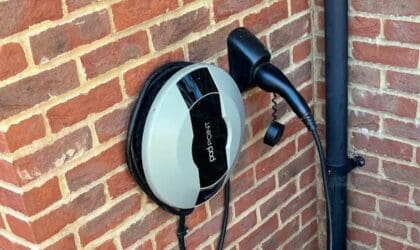
The low carbon landscape
The low carbon home energy sector is rapidly evolving, with technologies such as solar panels, wind turbines, and energy-efficient appliances all gaining traction. In this context, electric vehicles (EVs) are more than transportation, they’re integral to the energy transition, acting as mobile energy storage units that can feed back into the grid or home during peak demand.

This dynamic energy landscape creates opportunities for installers and specifiers, and Callum Russell, developer of EV information site Charging at Home, shares with us his insight into the benefit for the installer community of delivering fully integrated solutions.
Expanding your service offering by embracing the surge in EVs and integrated charging systems enables you to stay ahead of industry trends and meet the increasing consumer demand for efficient, low-carbon home energy solutions. Understanding and leveraging these trends is key to future-proofing your business.
Understanding integrated EV charging
EV charging technology spans from basic Level 1 chargers, utilising standard household outlets, to high-power Level 3 chargers for rapid charging. However, the growing trend is towards integrated EV charging, where the EV charger is harmonised with a home’s overall energy system.
The integration involves connecting the EV charger with the home’s energy management system (EMS). This linkage allows for smart power flow between the EV, home appliances, and possibly a home battery or solar PV system. Essentially, the EV becomes part of a home’s energy ecosystem rather than a separate entity merely drawing power.
Integrated EV charging operates on the principles of dynamic load balancing and demand response. It ensures optimal energy use by adjusting the charging speed based on real-time household energy consumption and grid conditions. Thus, it optimises charging times, improves grid stability, and enables better use of renewable energy.
The benefits
Energy efficiency and cost savings
Integrated charging aligns EV power demand with home energy usage, optimising consumption. This efficient use of power can significantly lower electricity bills and lead to cost savings over time.
Enhancing energy resilience
With the ability to balance power demand, integrated charging can minimise reliance on the grid during peak times, increasing home energy resilience and ensuring a reliable power supply.
Reducing carbon emissions
By efficiently utilising renewable energy for charging, integrated EV systems can significantly reduce carbon emissions associated with their operation, contributing to global efforts to mitigate climate change.
Load balancing and grid stability
Integrated systems can adjust to grid demands, absorbing excess power during low-demand periods and feeding back power during peak times, contributing to grid stability.
Use of renewable energy and battery storage
The systems can efficiently manage the use of renewable energy, charging EVs with excess solar or wind power during high production periods and drawing from battery storage when production is low.
The role and opportunities for installers
Installers and specifiers are at the forefront of the transition to integrated EV charging systems and need a deep understanding of the technology, installation techniques, and system optimisation to offer quality services. This includes knowledge of renewable energy sources, energy storage, and smart grid technologies.
The growth of EVs and the drive towards greener homes create exciting market opportunities. As consumers seek to maximise the efficiency of their home energy and EV charging, demand for skilled installers and specifiers is set to rise. Those who stay abreast of the latest technology and practices can differentiate themselves and capitalise on these opportunities.
However, navigating the regulatory landscape is equally important. Installers and specifiers must know relevant regulations, standards, and best practices for safe and effective installations. Understanding these requirements can improve service quality and build trust with clients and authorities, strengthening their position in the market.
Future trends
Technological advancements in the field of integrated EV charging and low carbon home energy solutions are rapidly unfolding. Innovations such as bi-directional charging, smart grid integration, and AI-driven energy management systems are poised to redefine the landscape, enhancing efficiency and user convenience.
Policy and regulatory developments are also key drivers. As governments worldwide incentivise EV adoption and low carbon technologies to combat climate change, regulations around EV charging infrastructure and energy efficiency standards are evolving. These changes are set to provide both challenges and opportunities for installers and specifiers.
The continued growth of EVs will undoubtedly amplify the demand for integrated charging. As more consumers embrace EVs and become aware of the benefits — from energy savings to grid resilience — we can expect a surge in the need for robust, efficient, and innovative charging solutions, solidifying this technology’s place in the future of sustainable energy.
Conclusion
Presenting a promising solution for optimising home energy systems, integrated charging can enhance efficiency, resilience, and sustainability while offering cost savings. As key players in this emerging field, installers and specifiers are instrumental in bridging the technology to consumers.
Staying informed and adaptable is paramount as the market evolves, driven by technological advances, policy changes, and increased EV adoption. Embracing this opportunity to shape the future of energy by learning and evolving alongside transformative technologies will secure your place in driving the transition towards low-carbon homes and a more sustainable world.


